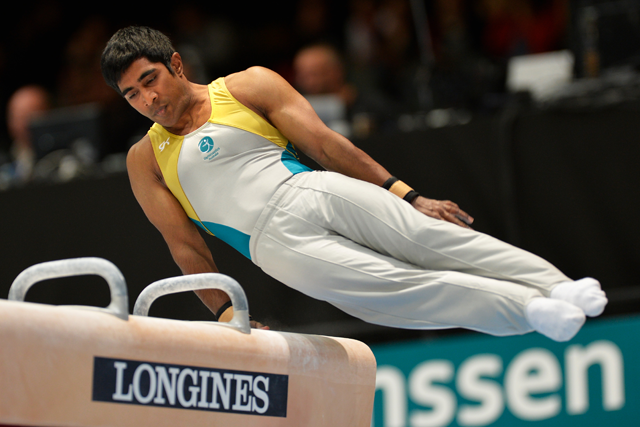Five Dock Leisure Centre gymnastics club offers opportunities for those gymnasts who wish to train more seriously to become a member of a squad. Known as our competitive program, they are split into two categories of Men's Gymnastics (MG) and Women's Gymnastics (WG). MG and WG are part of the national competitive program and allow the gymnast to compete at State, National and International competitions with other gymnasts from other clubs and states.
Registration
All competitive gymnasts must be registered with Gymnastics NSW.
Attire
Gymnasts must come to training properly attired. They should also bring a water bottle to training. Leotards, crop tops or fitted singlets and gym shorts are appropriate because they will not get caught in gymnastic equipment and allow the coaches to assess the shape and form of the gymnast.
All gymnasts are required to compete in the club leotard and club tracksuits at competitions. Gymnasts are allowed to wear their own choice of leotard at in-house competitions. A club polo shirt is also available.
If your child is selected into the WG Level 1 – 3 Inner City Region's State Team, you will need to purchase an additional leotard from the Regional.
 Men's Gymnastics (MG)
Men's Gymnastics (MG)
Men’s gymnastics provides a fun and safe energy outlet for boys of any age, where strength and discipline are key factors. Applying strength across six differing apparatus will build confidence and test any young thrill-seekers, through the development of mobility, endurance, flexibility and co-ordination. Men's gymnastics competition levels are split up into junior and senior events, catering from gymnasts as young as six up to adult competitors in the Masters division.
Competition apparatus (in Olympic order)
Floor exercise
A floor routine combines exciting and explosive power tumbling and acrobatic skills with composed balance and flexibility elements. A gymnast will perform somersaults, twists, static elements in connection to demonstrate gymnastics artistry.
Pommel horse
To master the pommel horse goes a long way to building the all-around confidence of a gymnast, as one of the harder men’s gymnastics apparatus’. Consisting of circular movements of the body (with legs together) and pendulous swings with the legs separated (scissors), the gymnast’s routine will consist of smooth combinations of these movements whilst turning and travelling along the horse.
Rings
The rings provide a perfect illustration of a gymnasts shear strength in undertaking a number of challenging hold elements. A gymnasts composure, control and discipline is tested in combining the strength holds with free swinging movements, before demonstrating their aerial abilities on the dismount.
Vault
The vault sees a male gymnast throw himself into a 25 metre run-up, in an effort to generate the necessary power to achieve the sufficient height to complete their aerial skills before landing. The gymnast will provide an explosive spectacle across two vaults, where the aerial acrobatic skills are completed in a matter of seconds.
Parallel bars
A predominately swinging apparatus, that is interspersed with only a few held or strength elements. Swings are completed above and below the bars and consist of acrobatic flight elements, changes of direction and swing types. The gymnast's routine ends in a dramatic dismount off the side or the end of the bars.
Horizontal bar
A spectacular apparatus sees the male gymnast combine swinging movements with strength and hold elements on a 2.8 metre high bar. Acrobatic releases and re-grasp flight elements provide heart in mouth entertainment, finished with a display of acrobatic talent in the dismount.
Women's Gymnastics (WG)
Women's competitive gymnastics provides girls with the opportunity to challenge themselves while building their strength, co-ordination and confidence in a fun and challenging environment. Focused on the four olympic apparatus (Vault, Uneven Bars, Beam and Vault), the gymnasts build routines based around strength, flexibilty, balance and body awareness.
Competition apparatus (in Olympic order)
Vault
Beginning with a 25m run, followed by a show of clean movements, height length and controlled landings the gymnasts demostrate their strong vaulting abilities. Competing the apparatus involves the demonstrations of strong take-off and aeiral awareness.
Uneven bars
Uneven Bars - requiring strength, precision, rhythm, concentration and courage; the gymnast moves from one bar to the other, alternating grip changes, releases and regrasps, saltos and changes of direction with circular swings.
Balance beam
A beam routine combines a number of acrobatic elements, including leaps, jumps, turns and other gymnastics movements. With each move performed across the 10cm wide beam, balance is an essential whilst gymnasts demonstrate elegance, flexibility and confidence.
Floor exercise
A gymnast’s floor routine is performed to a piece of music to enhance, where dance movements are combined with tumbling and acrobatics elements. The gymnast is required to use the whole floor area in expressing their individuality, originality and artistry, where creative input is a fun, yet important factor.
The competitive program in women's gymnastics follow routines and guidelines devised by Gymnastics Australia on the four apparatus: Vault, uneven bars, beam and floor. Classes vary in the number of hours and days the gymnasts train, the competitions they are eligible for and the overall commitment of each gymnast. The programs follow nationally set apparatus routines that are assessed at competition in front of a panel of judges. Gymnasts are split into Junior, Intermediate and Senior age groups when competiting.
The coaching staff at Five Dock Leisure Centre provide the optimal learning environment for each gymnast. The coaches cater to every learning style and adapt their techniques to suit the individual.
Once a gymnast has mastered the skills in a level, they may compete those skills in routines at the club for In-house, Invitationals, Regional and State organised competitions. As the gymnast progresses through the levels they achieve a sense of accomplishment and confidence within themselves. This allows all children to achieve and have success at gymnastics in a fun environment. Gymnasts within this program train 2 - 16 hours a week according to the level, age and commitment of the gymnast.
Within the competitive program, a very important component of their training is physical conditioning. Without mastering this, the gymnast will struggle with the demands of the sport. Physical conditioning will take up a proportion of the training time each session.

